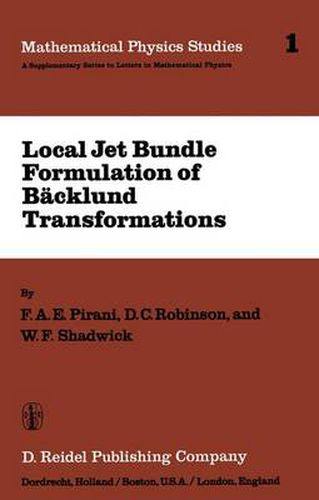Readings Newsletter
Become a Readings Member to make your shopping experience even easier.
Sign in or sign up for free!
You’re not far away from qualifying for FREE standard shipping within Australia
You’ve qualified for FREE standard shipping within Australia
The cart is loading…






The aim of this paper is to show that the theory of jet bundles supplies the appropriate setting for the study of Backlund trans formations. These transformations are used to solve certain partial differential equations, particularly non-linear evolution equations. Of course jets have been employed for some time in the theory of partial differential equations, but so far little use has been made of them in applications. In the meanwhile, substantial progress has been made in the study of non-linear evolution equations. This work has been encouraged by the dis covery of remarkable properties of some such equations, for example the existence of soliton solutions and of infinite se quences of conservation laws. Among the techniques devised to deal with these equations are the inverse scattering method and the Backlund transformation. In our opinion the jet bundle formulation offers a unifying geometrical framework for under standing the properties of non-linear evolution equations and the techniques used to deal with them, although we do not consider all of these properties and techniques here. The relevance of the theory of jet bundles lS that it legitimates the practice of regarding the partial derivatives of field variables as independent quantities. Since Backlund trans formations require from the outset manipulation of these partial derivatives, and repeated shifts of point of view about which variables are dependent on which, this geometrical setting clari fies and simplifies the concepts involved, and offers the prospect of bringing coherence to a variety of disparate results.
$9.00 standard shipping within Australia
FREE standard shipping within Australia for orders over $100.00
Express & International shipping calculated at checkout
The aim of this paper is to show that the theory of jet bundles supplies the appropriate setting for the study of Backlund trans formations. These transformations are used to solve certain partial differential equations, particularly non-linear evolution equations. Of course jets have been employed for some time in the theory of partial differential equations, but so far little use has been made of them in applications. In the meanwhile, substantial progress has been made in the study of non-linear evolution equations. This work has been encouraged by the dis covery of remarkable properties of some such equations, for example the existence of soliton solutions and of infinite se quences of conservation laws. Among the techniques devised to deal with these equations are the inverse scattering method and the Backlund transformation. In our opinion the jet bundle formulation offers a unifying geometrical framework for under standing the properties of non-linear evolution equations and the techniques used to deal with them, although we do not consider all of these properties and techniques here. The relevance of the theory of jet bundles lS that it legitimates the practice of regarding the partial derivatives of field variables as independent quantities. Since Backlund trans formations require from the outset manipulation of these partial derivatives, and repeated shifts of point of view about which variables are dependent on which, this geometrical setting clari fies and simplifies the concepts involved, and offers the prospect of bringing coherence to a variety of disparate results.